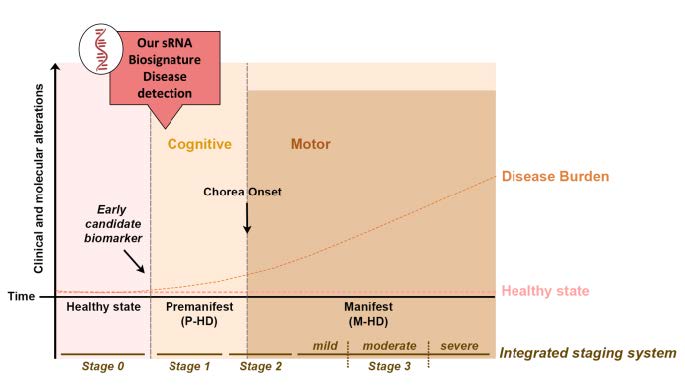
sRNA biosignature for the early diagnostic of neurodegenerative diseases
Advantages
- sRNAs expression patterns are highly dynamic and correlate with early symptomatology.
- sRNA offer a layer of specificity, differing from other protein-based biomarkers.
- A small group of sRNAs is sufficient to optimally diagnose premanifest cases.
- sRNAs expression may complement neurofilament (NfL) determinations in HD premanifest stages.
Goal
The group is looking for a license agreement, but other collaborations may be considered..
Intellectual Property
Patent EP23382178
Priority date: 27 February 2023
Reference
UBTT0468
Contact
Rosa Vázquez
Email: rvazquez@fbg.ub.edu
Tel: +34 934 039639
sRNA biosignature for the early diagnostic of neurodegenerative diseases
Executive summary
A research group, with wide experience on functional genomics, working in the understanding of disease-driven deregulation of small-RNAs and their role in neuronal dysfunction, has generated a set of RNA based biomarkers for diagnosis and prognosis of human neurodegenerative diseases (i.e. Huntington disease).
Introduction
Major current challenges in translational biomedicine are (i) to evaluate the potential of sRNAs as disease-specific, peripheral non-invasive biomarkers and (ii) to understand the functional and pathogenic relevance of these species, which may help to unravel disease mechanisms and identify therapeutic targets.
Huntington’s disease (HD) is a dominant inherited genetic disorder caused by a CAG trinucleotide repeat expansion in the Huntingtin (HTT) gene. Mutation induces a gradual degeneration of specific brain areas and the appearance of progressive clinical symptoms such as progressive motor abnormalities and early cognitive decline. HTT mutation carriers may present diverse alterations long before (premanifest stages, P-HD) the development of the unequivocal motor symptoms that define the disease onset (manifest HD, M-HD). Specific biomarkers able to track disease progression at this premanifest stage (P-HD) are key to take treatment decisions.
In HD, pathogenic mechanisms are complex and diverse types of small RNAs (sRNAs) have been uncovered as neurotoxic drivers. In different neurodegenerative diseases, including HD, altered expression of sRNAs occurs long before clinical symptoms start. These changes can be peripherally detected in plasma and cerebrospinal fluids, where sRNAs circulate either free, bound to proteins/lipids, and/or encapsulated within extracellular vesicles (EVs).
Description
The present technology consists of a novel biosignature of sRNAs in plasma of HTT-mutation carriers with specific species sensing the progression and cognitive changes occurring at the premanifest stage (P-HD). This technology can be applied to diverse disease, with analogous unmet needs.
Current stage of development
The candidate sRNA biosignature are identified and validated for Huntington disease. Further development in terms of optimization in the procedure could be applied (i.e no RNA extraction-needed, pre-amplification, or pre-labeling), to achieve direct detection and absolute quantification of candidate sRNAs.

